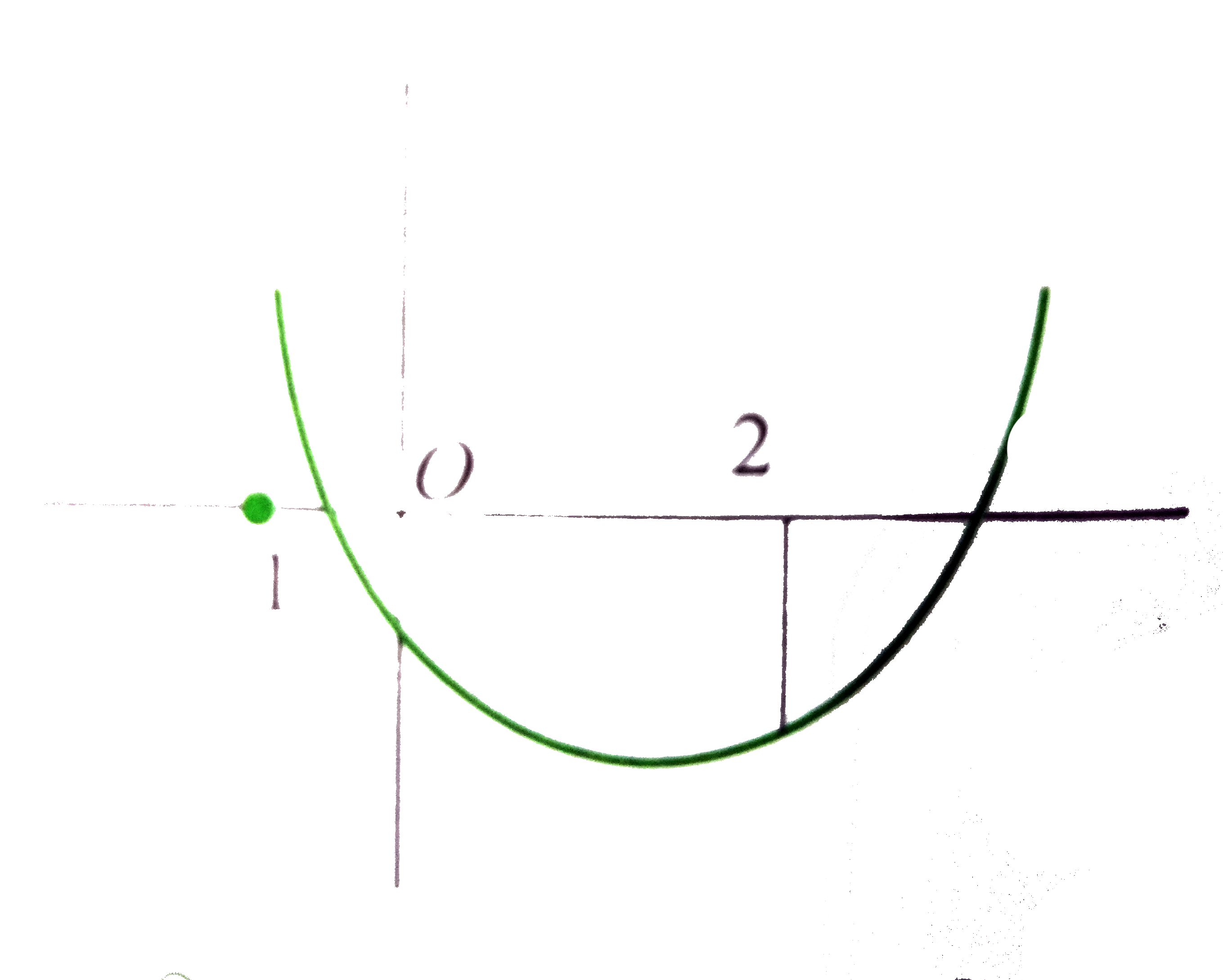The range of a for which the equation x2+x−4=0 has its smaller root in the interval (−1,2)is (−∞,−3) b. (0,3) c. (0,∞) d. (−∞,−3)∪(0,∞)Solution in Bengali
(−∞,−3)
(0, 3)
(0,∞)
(−∞,−3)∪(0,∞)
The correct Answer is:A
Clearly , f(−1)>0,f(2)<0
Now ,
f(0)=−4<0
⇒f(−1)=1−a−4>0
and f(2)=4+2a−4<0
⇒a<−3anda<0
⇒a∈(−∞),−3)

Topper's Solved these Questions
- BOOK - CENGAGE PUBLICATIONCHAPTER - THEORY OF EQUATIONSEXERCISE - Multiple Correct Answer Type38videos
THEORY OF EQUATIONS
- BOOK - CENGAGE PUBLICATIONCHAPTER - THEORY OF EQUATIONSEXERCISE - Linked Comprechension Type37videos
THEORY OF EQUATIONS
- BOOK - CENGAGE PUBLICATIONCHAPTER - THEORY OF EQUATIONSEXERCISE - CONCEPT APPLICATION EXERCISE 2.139videos
THEORY OF EQUATIONS
- BOOK - CENGAGE PUBLICATIONCHAPTER - STRAIGHT LINESEXERCISE - ARCHIVES (NUMERICAL VALUE TYPE)1videos
STRAIGHT LINES
- BOOK - CENGAGE PUBLICATIONCHAPTER - THREE DIMENSIONAL GEOMETRYEXERCISE - All Questions291videos
THREE DIMENSIONAL GEOMETRY
Similar Questions
If c≠0 and the equation p2x=ax+c+bx−c has two equal roots, then p can be
03:26View SolutionConsider an unknow polynomial which divided by (x−3) and (x−4) leaves remainder 2 and 1, respectively. Let R(x) be the remainder when this polynomial is divided by (x−3)(x−4).
If equations R(x)=x2+ax+1 has two distint real roots, then exhaustive values of a are.02:40View SolutionFind the values of a if x2−2(a−1)x+(2a+1)=0 has positive roots.
02:56View SolutionFor a point P in the plane, let d1(P)andd2(P) be the distances of the point P from the lines x−y=0andx+y=0 respectively. The area of the region R consisting of all points P lying in the first quadrant of the plane and satisfying 2≤d1(P)+d2(P)≤4, is
02:41View SolutionFind the angle between the line whose direction cosines are given by l+m+n=0andl2+m2−n2=0.
06:38View SolutionThe range of a for which the equation x2+ax−4=0 has its smaller root in the interval (−1,2)is a. (−∞,−3) b. (0,3) c. (0,∞) d. (−∞,−3)∪(0,∞)
01:57View SolutionFor x2−(a+3)|x|+4=0 to have real solutions, the range of a is (−∞,−7]∪[1,∞) b. (−3,∞) c. (−∞,−7) d. [1,∞)
03:56View SolutionIf the equation x3−12x+a=0 has exactly one real root, then range of a is equal to (−∞, −16)∪(16, ∞) (b) {−16, 16} (−16, 16) (d) (−∞, −16)∪[16, ∞)
02:47View SolutionThe range of the function f(x)=|x−1| is
A. (−∞,0)
B. [0,∞)
C. (0,∞)
D. R02:37View SolutionThe domain of the function f(x)=√(x+1)(x−3)x−2 is [−1,2)∪[3,∞) b. (−1,2)∪[3,∞) c. [−1,2]∪[3,∞) d. none of these
03:02View SolutionThe set of points where the function f(x)=x|x| is differentiable is (a) (−∞, ∞) (b) (−∞, 0)∪(0, ∞) (c) (0, ∞) (d) [0, ∞]
01:32View SolutionThe range of a for which the equation x2+ax−4=0 has its smaller root in the interval (−1,2)is a. (−∞,−3) b. (0,3) c. (0,∞) d. (−∞,−3)∪(0,∞)
03:43View SolutionFor x2−(a+3)|x|+4=0 to have real solutions, the range of a is a. (−∞,−7]∪[1,∞) b. (−3,∞) c. (−∞,−7) d. [1,∞)
02:44View SolutionFor x2−(a+3)|x|=4=0 to have real solutions, the range of a is a(−∞,−7]∪[1,∞) b(−3,∞) c(−∞,−7] d[1,∞)
02:02View SolutionLet A(0,2),B and C be points on parabola y2+x+4 such that ∠CBAπ2. Then the range of ordinate of C is (a) (−∞,0)∪(4,∞) (b) (−∞,0]∪[4,∞) (c) [0,4] (d) (−∞,0)∪[4,∞)
04:10View SolutionFor x2−(a+3)|x|−4=0 to have real solutions, the range of a is
a)(−∞,−7]∪[1,∞)
b)(−3,∞)
c)(−∞,−7]
d)[1,∞)02:15View Solution

